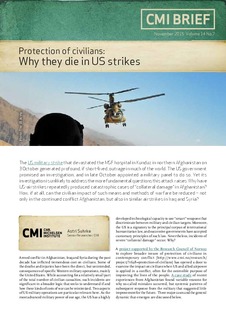| dc.contributor.author | Suhrke, Astri | |
| dc.date.accessioned | 2018-01-04T08:20:06Z | |
| dc.date.available | 2018-01-04T08:20:06Z | |
| dc.date.issued | 2015-01-01 | |
| dc.identifier | oai:www.cmi.no:5666 | |
| dc.identifier.citation | Bergen: Chr. Michelsen Institute (CMI Brief vol. 14 no. 7) 5 p. | |
| dc.identifier.issn | 0809-6732 | |
| dc.identifier.uri | http://hdl.handle.net/11250/2475069 | |
| dc.description.abstract | Read online
The US military strike that devastated the MSF hospital in Kunduz in northern Afghanistan on 3 October generated profound, if short-lived, outrage in much of the world. The US government promised an investigation, and in late October appointed a military panel to do so. Yet its investigation is unlikely to address the more fundamental questions this attack raises: Why have the US-airstrikes repeatedly produced catastrophic cases of “collateral damage” in Afghanistan? How, if at all, can the civilian impact of such means and methods of warfare be reduced – not only in the continued conflict Afghanistan, but also in similar airstrikes in Iraq and Syria? | |
| dc.language.iso | eng | |
| dc.publisher | Chr. Michelsen Institute | |
| dc.relation | CMI Brief | |
| dc.relation | 7 | |
| dc.relation.ispartof | CMI Brief | |
| dc.relation.ispartofseries | CMI Brief vol. 14 no. 7 | |
| dc.relation.uri | https://www.cmi.no/publications/5666-protection-of-civilians | |
| dc.subject | US Military Strike | |
| dc.subject | Protection of Civilians | |
| dc.subject | Afghanistan | |
| dc.subject | Iraq | |
| dc.subject | Syria | |
| dc.title | Protection of civilians: Why they die in US strikes | |
| dc.type | Report | |
